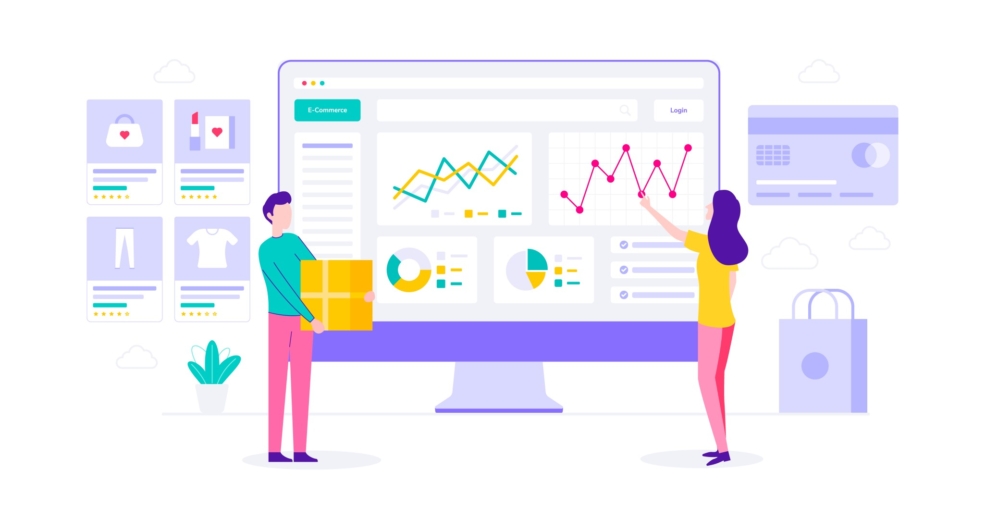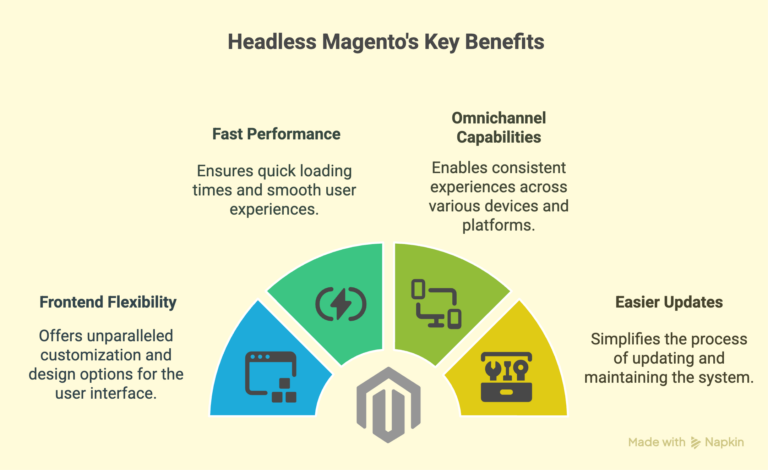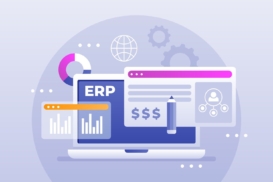Greetings! I'm Aneesh Sreedharan, CEO of 2Hats Logic Solutions. At 2Hats Logic Solutions, we are dedicated to providing technical expertise and resolving your concerns in the world of technology. Our blog page serves as a resource where we share insights and experiences, offering valuable perspectives on your queries.

Quick Summary
Headless Magento separates the frontend user experience from the backend business logic, offering benefits like improved performance, greater flexibility, and true omnichannel capabilities. While it requires more development resources, it can provide significant competitive advantages for businesses with complex needs or ambitious growth plans.
Ever found yourself in a meeting where developers enthusiastically discuss “headless commerce” while you smile and nod, secretly wishing for a translation? You’re not alone.
As digital commerce evolves at breakneck speed, understanding headless architecture isn’t just for the technical team anymore. It’s becoming essential knowledge for everyone involved in e-commerce strategy.
Let’s demystify headless Magento in plain English, so you can confidently join those conversations and make informed decisions for your business.
What Exactly is “Headless” Magento?
In traditional e-commerce platforms, the “head” (frontend/presentation layer) and “body” (backend/business logic) are tightly coupled.
When someone visits your store, the backend processes the request and delivers a complete webpage to the visitor.
Headless Magento, however, separates these components:
- The backend handles business logic, inventory, pricing, user data, etc.
- The frontend is completely independent and connects to the backend via APIs
The Four Key Benefits of Headless Magento

1. Ultimate Frontend Flexibility
With traditional Magento, you’re somewhat constrained by its frontend frameworks and themes. Headless Magento liberates your creative team to build interfaces using any technology they prefer.
Real-world example: One of our clients, a luxury fashion retailer, wanted a highly interactive product customization experience that wasn’t possible with traditional Magento themes. By going headless, they built a React-based frontend that allowed shoppers to visualize product customizations in real-time, increasing their average order value by 24%.
2. Blazing Fast Performance
Traditional Magento sites load the entire page with each user interaction. Headless implementations typically use modern JavaScript frameworks (React, Vue, Angular) that only update the necessary parts of a page.
This approach leads to significantly faster page load times and smoother user experiences.
Speed comparison table:
| Metric | Traditional Magento 2 | Headless Magento (PWA) |
|---|---|---|
| Initial Page Load | 3-5 seconds | 1-2 seconds |
| Product Page Navigation | 2-3 seconds | Under 0.5 seconds |
| Add to Cart Action | 1-2 seconds | Near instantaneous |
Pro Tip: When implementing headless Magento, consider using a headless CMS alongside it to manage content seamlessly across all your touchpoints.
3. Omnichannel Capabilities
Want your products to be accessible on mobile apps, smart mirrors, voice assistants, and whatever comes next? Headless makes this much easier.
The same backend can power all your sales channels through APIs, ensuring consistent product information, pricing, and inventory across every touchpoint.
Example: We helped a household appliance brand expand from their traditional website to a mobile app, in-store kiosks, and voice shopping through Google Assistant all powered by the same Magento backend. This omnichannel approach led to a 37% increase in overall sales within six months.
Need help designing your omnichannel strategy with headless Magento?
4. Easier Updates and Maintenance
With traditional Magento, updating your frontend often means carefully testing to ensure you haven’t broken backend functionality.
In a headless setup, developers can work on the frontend and backend independently:
- Frontend team can redesign the user experience without touching the backend
- Backend team can improve business logic without disrupting the customer-facing application
This separation leads to faster development cycles and more agile implementation of new features.
The Challenges of Going Headless
Let’s be honest, headless isn’t all sunshine and rainbows. Here are some challenges to consider:
- Higher initial development costs Headless implementations typically require more upfront investment in custom development compared to using pre-built Magento themes.
- Need for specialized developer skills You’ll need developers who understand both Magento’s API architecture and modern frontend frameworks.
- More complex infrastructure Instead of managing one application, you’re now managing multiple interconnected services.
- Potential feature gaps Some built-in Magento features may require additional work to implement in a headless setup.
Is Headless Magento Right for Your Business?
Headless Magento is particularly valuable for businesses that:
- Need exceptional site performance
- Have complex or unique frontend requirements
- Want to deliver consistent experiences across multiple channels
- Have separate teams working on frontend and backend
- Plan to scale significantly in the coming years
Getting Started: Implementation Approaches
There are several ways to implement headless Magento, depending on your specific needs and resources:
1. PWA Studio Approach
Magento’s own Progressive Web App (PWA) Studio provides tools for building headless storefronts that work with Magento’s API.
Pros:
- Official Magento solution
- Growing community support
- Built specifically for Magento’s API
Cons:
- Still maturing compared to other frontend frameworks
- Less flexibility than completely custom implementations
2. Custom Frontend Implementation
Build a completely custom frontend using your preferred JavaScript framework (React, Vue, Angular, etc.).
Pros:
- Maximum flexibility and customization
- Freedom to choose any technology stack
- Potential for optimal performance optimization
Cons:
- Requires significant development expertise
- Higher development costs
- More maintenance responsibility
3. Hybrid Approach
Keep some pages on traditional Magento while implementing headless architecture for specific high-value sections of your site.
Pros:
- Lower initial investment
- Gradual transition
- Focus headless resources on highest-impact areas
Cons:
- More complex to manage
- Inconsistent user experience
- Technical debt from maintaining two systems
Technical Components (in Non-Technical Terms)
Even as a non-developer, understanding the basic components of a headless Magento implementation will help you communicate more effectively with your technical team:
1. Magento API
The Application Programming Interface (API) is the communication layer that allows the frontend to request and receive data from the Magento backend.
Magento 2 offers two main API types:
- REST API: Simpler, more commonly used
- GraphQL API: More efficient, allows frontend to request exactly the data it needs
2. Frontend Technologies
Common technologies used for headless Magento frontends include:
- React: Facebook’s JavaScript library, popular for dynamic interfaces
- Vue.js: Lightweight framework known for ease of use
- Next.js/Nuxt.js: Frameworks that add server-side rendering capabilities
- PWA Studio: Magento’s toolkit for building Progressive Web Apps
3. Middleware (Optional)
Some implementations use middleware, a layer between the frontend and backend that:
- Caches data to improve performance
- Combines data from multiple sources
- Transforms data into formats the frontend needs
Examples include Node.js servers, BFF (Backend for Frontend) patterns, or specialized commerce middleware platforms.
Looking for help planning your headless Magento migration?
Future-Proofing with Headless Magento
The e-commerce landscape continues to evolve rapidly. Headless architecture positions your business to adapt to emerging trends:
- Conversational commerce: Voice shopping through smart speakers and assistants
- Augmented reality shopping: Virtual try-on and product visualization
- IoT commerce: Connected devices that can place orders
- Social commerce: Seamless shopping experiences embedded in social platforms
With a headless foundation, adding these capabilities becomes a matter of creating new frontends that connect to your existing Magento backend, rather than rebuilding your entire commerce platform.
Conclusion: Is Headless Magento Your Next Move?
Headless Magento offers compelling benefits for businesses seeking performance, flexibility, and omnichannel capabilities. However, it’s not the right solution for everyone.
Consider headless Magento if:
- Your current site performance is holding back conversions
- You need distinctive customer experiences beyond standard templates
- You’re expanding to multiple customer touchpoints
- You have the technical resources to support a more complex architecture
Stick with traditional Magento if:
- Your business needs are well-served by existing Magento themes
- You have limited development resources
- You need to minimize upfront implementation costs
- Your current architecture isn’t limiting your business growth
Whatever path you choose, the key is aligning your technology decisions with your unique business goals and customer needs.
Ready to explore whether headless Magento is right for your business?
Contact our team at 2HatsLogic for a free assessment and personalized recommendations for your e-commerce strategy.
FAQ
What are the main benefits of headless Magento?
Faster page loads, custom user experiences, seamless multi-channel selling, and more efficient development workflows.
Is headless Magento more expensive?
Yes. Initial costs are higher due to custom development, but many businesses see better conversion rates that offset this investment over time.

Related Articles







